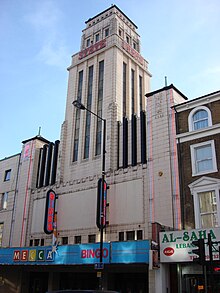Gaumont-British

The Gaumont-British Picture Corporation was a company that produced and distributed films and operated a cinema chain in the United Kingdom.
It was founded in 1898 as the British subsidiary of the French Gaumont Film Company. It became independent of its French parent in 1922 when Isidore Ostrer acquired control of Gaumont-British. In 1927 a leading silent film maker, the Ideal Film Company, merged with Gaumont.
The company's Lime Grove Studios made films including Alfred Hitchcock's adaptation of The 39 Steps (1935), while its Islington Studios made Hitchcock's The Lady Vanishes (1938).[1] In the 1930s the company employed 16,000 people.
In the USA Gaumont-British had its own distribution operation for its films until December 1938, when it outsourced distribution to 20th Century Fox. In 1941 the Rank Organisation bought Gaumont-British and its sister company Gainsborough Pictures.
Cinemas

Gaumont-British developed or acquired large "super-cinemas" such as the New Victoria (later Gaumont and finally Odeon) in Bradford opened in 1930, the Gaumont in Manchester opened in 1935, and the Gaumont State Cinema in Kilburn, London, opened in 1937.
Many of its cinemas had a theatre organ for entertainment before the show, in the intervals, or after the show. The name "Gaumont" was adopted to describe the style of the flat-top organ console case (originally for the Pavilion Theatre, Shepherd's Bush[2]), for some Compton organs built from October 1931 to 1934.

Cinema exhibition in the UK was characterised by alignments between exhibitors and distributors. After the Odeon and Gaumont takeovers, Rank had access to the product of 20th Century Fox, Paramount, Walt Disney, Columbia, Universal, United Artists and its own film productions. Rivals ABC had only Warner Brothers, MGM and its own ABPC productions (both also took films from smaller distributors). With ample supply of product, Rank maintained the separate Odeon and Gaumont release pattern for many years. Some Odeon cinemas were renamed Gaumont when transferred to Gaumont release. As attendances declined during the 1950s many cinemas on all circuits were closed and eventually, the booking power of the Gaumont circuit declined. In January 1959 Rank restructured its exhibition operation and combined the best Gaumonts and the best Odeons in a new Rank release, while the rest were given a new "National" release. In 1961, Paramount objected to Rank consigning its Dean Martin comedy All in a Night's Work to the national circuit and henceforth switched its allegiance to the ABC circuit. With the continuing decline in attendances and cinema numbers, the National release died on its feet and henceforth there were two release patterns, Rank and ABC. There was no reason to perpetuate the Gaumont name and in towns that lost their Odeon, the Gaumont was usually renamed Odeon within a couple of years of the latter's closure. Even so, the Gaumont name continued to linger until, in January 1987, the last Gaumont, in Doncaster, was renamed Odeon.
G.B. Equipments Ltd and G.B.-Bell & Howell

A subsidiary of Gaumont British — G.B. Equipments Ltd made a number of 16 mm film sound projectors in Britain before and during WWII, including models such as the G.B.-Scope A and B, Grosvenor and G.B. K and L series.[3]
After WW II G.B. Equipments Ltd decided not to manufacture models of their own — instead they began to manufacture, under license, models of American design by Bell & Howell. These models, branded as either G.B.-Bell & Howell or Bell & Howell-Gamount in Great Britain, were identical to the American models except in model number.[3] During the 1950s G.B.-Bell & Howell either manufactured, or distributed, a number of 8 mm and 16 mm cine-cameras and projectors.[4][5]
G.B.-Kershaw and G.B.-Kalee
In 1888 Abram Kershaw established a business in Leeds making photographic items, including lanterns and projection equipment. Kershaw produced cinema projectors under the Kalee trade name (from the initials of Kershaw, A, Leeds) from the 1910s.[6][7] Later, the company became part of Amalgamated Photographic Manufacturers, forming the Kershaw-Soho Ltd group.[8]
The brand Kalee continued to be used until the Kershaw group was acquired by Gaumont British to become G.B.-Kalee Ltd.[8] Both GB-Kershaw and GB-Kalee were used as brand names for a range of 8 mm and 16 mm cine-cameras, movie projectors, slide projectors and still cameras.[5][9] G.B.-Kalee was also the distributor in the United Kingdom for the 16 mm and 35 mm Arriflex cinema camera[9] as well as a range of professional cinema projectors and sound equipment under the brand name Gaumont-Kalee.[10]
See also
References
- ^ Warren, Patricia (2001). British Film Studios: An Illustrated History. London: B.T. Batsford. p. 109.
- ^ Buckingham, Ivor. "Organ cases and illuminated surrounds". The Compton List. Retrieved 6 December 2008.
- ^ a b "Pre-war Sound Projectors". Amateur Cine World: 467–468. October 1966.
- ^ "G. B. Bell and Howell". Retrieved 18 June 2015.
- ^ a b "G.B. Equipments". Retrieved 18 June 2015.
- ^ "Abram Kershaw and Sons". Retrieved 19 June 2015.
- ^ "A. Kershaw and Son". Retrieved 19 June 2015.
- ^ a b "Gaumont-Kalee, GB-Kalee, Rank Precision Industries, Kershaw; London". Retrieved 19 June 2015.
- ^ a b "G. B. Kalee". Retrieved 19 June 2015.
- ^ "The Gaumont-Kalee "20" with the "President"". Retrieved 19 June 2015.
